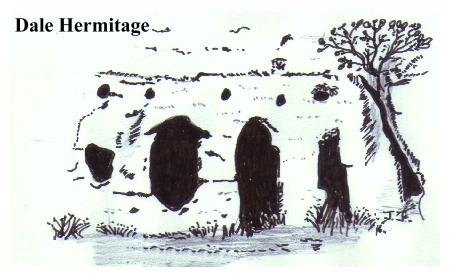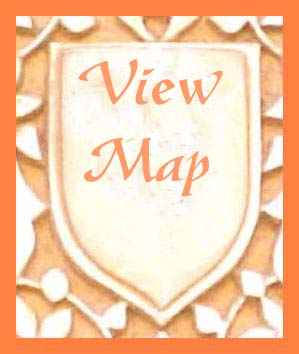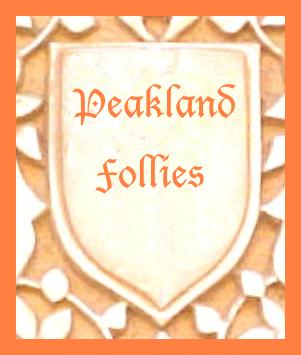5. DALE HERMITAGE
An easy walk through pleasant rolling countryside, visiting a rock cut hermitage and the only church in England that shares its roof with a farm!
Getting There: From Ilkeston (junction from the M1) take the A6096 towards Derby. On entering Kirk Hallam turn left onto St Norbert Drive, which leads through a council housing estate. Turn left onto Wirksworth Road. (If you miss St. Norbert Drive, you can turn into its opposite end a short way further along the main road, just before reaching the Cat & Fiddle Pub - this will of course involve a right turn onto Wirksworth Road). A short distance along, opposite a grass verge and 'crescent' of council houses, a gravel track (easily missed!) leads between two houses to the little carpark at Pioneer Meadows.
Distance: 4 miles
Map ref: Pathfinder Series Nottingham (South West) SK 43/53
Rating: Walk ** Follies and General Interest **
With every morn's uprising; Pouring wide,
Along dark aisles a splendour still the same
As when, each dewy prime, with reverent guide,
The white robed company adoring came.
And now thou standest, broken, bare and lone,
Reft of thy pride, a crumbling frame of stone.
THOS. L. TUDOR 'Dale Abbey'
Pioneer Pond, hidden in thickets adjacent to Pioneer Meadows carpark at the start of our walk, was originally an ironstone pit, and is recorded as such on the first ordnance survey map of 1881.In those days the pond was breasted by a tramway which was used to transport raw materials. Also nearby stood 'Dale Abbey No 1' Colliery. All trace of this has now vanished. In 1979 the pond was described in the Ilkeston Advertiser as being a 'filthy fishing spot', choked with rubbish etc. Since then the place has been much improved by the Erewash Borough Council and today, despite the proximity of a large council estate, the area has been turned into a promising local recreational area.
From Pioneer Meadows carpark we take the middle one of three recently surfaced paths, passing woods & Pioneer Pond on the right, to cross a small metal footbridge over the Sow Brook. Bear right and follow the field edge. In the second field the path bears diagonally to the left. Cross the stile and bear right of the pylon. Do not cross the stream, instead, bear right to pass through two stiles in quick succession on the track bed of the old mineral railway. Follow the hedge to the next stile, bearing left across the next field to its far corner. Bear left through a gateway and follow the track up to Furnace Pond.
(I found it confusing here - head for the lane on the far side of the pond).
Furnace Pond is a peaceful little spot, a haunt of anglers. It looks little more than a fairly shallow, muddy little pond. Nevertheless it is recorded that in 1905 John Padgett, a local collier, saved three people from drowning in its turgid waters. It would seem as the saying goes, that 'still waters run deep'!
On entering the lane just above Furnace Pond Farm, bear left following the metalled farm road to the junction with Hixon's lane. Turn right and follow Dale Road,( a fine promenade along the hillside) to its junction with Potato Pit Lane and Woodpecker Hill. Pass through a field gate, and continue onwards along the bridleway below Hermit's Wood, which is eventually entered at the end of the field. Just beyond, a few steps on the left lead up to the Hermitage.

Dale Abbey began here, at this hermit's cell cut out of the soft sandstone. The story goes that sometime around 1130 AD, a Derby baker had a vision of the Virgin Mary who instructed him to go to 'Depedale' and there to worship and dwell in piety and solitude. The baker promptly upped stumps and set off on his quest. And 'quest' it was indeed, for the poor man knew not where 'Depedale' was! Tramping dejectedly through Stanley village one day, he overheard a woman ordering a girl to drive some calves up to Depedale. Thereupon he followed the girl, and thus it was that the poor baker gained his 'promised land'.
When he reached Depedale however, he found nothing but marsh, forest and wild beasts and not a human soul in miles. Undeterred, he carved this cave out of the hillside, using the eastern end as a cell and the western end as a chapel.
News soon travelled of the Hermit living out at Dale. A local nobleman, who discovered the hermit whilst hunting, was moved by his piety and gave him a small income. Nearby, the hermit found a spring, still known as the Hermit's Well, and, thus established, lived out the rest of his days here.
But this is just the beginning of the story. After the baker's death a succession of hermits dwelt here, most of them patronised by the 'Gome', or Godmother, a rich local lady who inspired by the vision of the Derby Baker had settled at Dale and built onto the Hermit's Chapel. A portion of her building still exists in the present church, which is our next port of call.
Retrace your steps to the path and turn left, entering the farmyard of Church Farm beyond a gate. The route now leads without complication down past All Saints churchyard and thence to Dale Abbey.
All Saints Church is a most curious structure. Prior to 1754 it was an 'instant wedding centre', a Midlands equivalent of Gretna Green where couples could be quickly married, without banns being read. Legend has it that Robin Hood's henchman, Alan a Dale, was married here (a distinction also claimed by Steetley Chapel). Certainly there is a 'Sherwood Forest' kind of feel about the place! The abbey infirmary was built onto the church, the gallery upstairs allowing the sick stretcher patients to view the altar. The infirmary later became the Blue Bell Inn, and a connecting door is said to have led from Salvation to Damnation! The present vestry, it is said, was originally the bar! The church contains much of interest (though it was locked when I was there - a sad and alas, necessary fact of life in these times!). Its pulpit, dated 1634, leans crazily, and the north wall displays a fresco dating from around 1300. The church uses the original Dale Abbey Font,(of which more shortly), and the lovely interior, with its box pews has changed little since the mid seventeenth century.
Sadly there is less to see of Dale Abbey. A brief Diversion through the second stile on the right will enable you to take in the Dale Abbey 'Arch', the shattered east window of the abbey, which is all that remains of this once great church. Nearby Abbey House exhibits ancient masonry, the remains of the Abbey's kitchen chimney, (which was once used as an air raid shelter!) and an adjacent garage still shows traces of the Abbey's Cellarium. To the left of the main street, behind the former Methodist Church, the remains of the Abbey Gatehouse still stand. This was once used as a 'lockup' for convicts en route fron Nottingham to Derby! There is little else to see above ground, and it is hard to imagine the great Church and Abbey complex that once existed here.
Like the Hermitage, Dale Abbey began with a vision. A local outlaw, it is said, a profane and godless man, saw a golden cross standing on the site where the Abbey Church would one day be built. He saw 'men coming from all nations and adoring that cross most devotedly'. Not long afterwards the Gome persuaded her nephew to found a monastery here, but there were to be many failures and further attempts before the monastery eventually was built. The Abbey, dedicated to St. Mary, was finally inaugurated on 15th August 1204. It was a Premonstratensian House, an abode of white robed Canons, whose order was founded by St. Norbert at Pr—montr— in France. Dale Abbey was not a Fountains or a Kirkstall. It was a medium sized establishment, housing in its prime an abbot and twenty-three canons, this number dwindling greatly in later years. The Abbey was self supporting; it had its own fishponds and much of its business was involved with farming and horticulture, as well as sheltering the poor and the sick. All this came to an abrupt end, of course, when Henry VIII suppressed the monasteries around 1538. Most of Dale Abbey was sold to Francis Pole of Radbourn, near Derby, who, to quote a time worn expression 'copt for the lot'! He did not, however, get his paws on the abbey bells, which disappered without trace, along with various abbey treasures reutedly thrown down a now lost well, which has given rise to many legends of 'buried treasure' in the neighbourhood.
The abbot and canons, unlike many of their more militant northern brethren, were generously pensioned off and no doubt lived in happy retirement.
Thereafter, 'bits' of Dale Abbey found their way into churches all over the area. The Abbey's ornate wooden font cover is now at Radbourn Church, while the font itself became a flower vase on the lawn at Stanton Hall. It was returned to Dale in 1860, and was put in the churchyard, before being put back into service in the church once more.
From the Abbey Window retrace your steps to the lane. Bear right and follow the lane up through the village passing the former methodist church (Now the Gateway Christian Centre) on the left.(Note Abbey gatehouse behind.) Continue onwards to the road junction opposite the Carpenters Arms.
Considering its proximity to urban areas and the coalfield, the little community of Dale Abbey is, despite the vicissitudes of time, a centre of christian worship, and a haven of peace and tranquillity for christians and non-christians alike, tucked away from the hustle and bustle of nearby urban sprawl. The Gateway Christian Centre offers the most scrumptious (and inexpensive) cream teas, and numerous (free) walkers guides may be obtained for the surrounding area. For those desirous of stronger liquid refreshment, the Carpenters Arms is a most excellent hostelry to bask outside of on a summers day!
Enter the farm track to the left of the pub, then follow a signed footpath which passes over a stile in the carpark at the back of the pub, bearing diagonally right across the field to a stile in the hedge. From here, a footpath ascends, without complication, to the busy A6096.
On reaching the main road, bear right (towards Ilkeston). Then a short distance on, cross the road, and proceed a short way up Cat and Fiddle lane, for a look at the Cat and Fiddle Windmill. This fascinating and near unique structure was built in 1788 on the site of the Abbots original Kirk Hallam Mill. The mill's sails were turned into the wind by by means of a long pole connected to the rear. The mill was last used in 1952, and is one of the few remaining post mills in the country.The Mill is on private land, as the notice at the end of the farm road points out, but but a good view of it may be obtained without straying from the lane end.(If a closer inspection is required this may be acheived by dialling 01602 301585 for permission).
Retrace your steps to the main road, and cross to a stile slightly to the right of the junction, by a bus stop. Descend the fields, eventually bearing to the left of a plantation which once housed the drift mine of Dale Abbey No 2 Colliery. On reaching the bottom of the wood. bear left along a well defined footpath which meanders without complication back to Kirk Hallam.
On reaching the recreation ground on the edge of the Kirk Hallam Estate, bear right down the edge of the first field, pass through a gap then turn sharp left, to join an track running between the edge of the estate and a line of ramshackle garages. Beyond the garages bear right through an iron gate, then just before reaching the next gate pass left through a stile, from which a path leads back to the Pioneer Meadows carpark, passing Pioneer Pond on the right.







